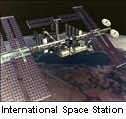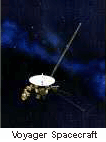|
Spacecraft and the Earth's Magnetosphere
Satellites inside the Earth’s Magnetosphere
Normally the magnetosphere provides a degree of shielding
and protection to satellites within its borders, but satellites
orbiting earth are particularly vulnerable to blasts of solar
energy resulting from the sun's high-energy eruptions. The
effects vary according to the satellite's orbit, its position
relative to certain regions in space, and the stage of the
Solar Max cycle.
Satellites in the highest orbits are susceptible to bursts
of high energy particles being trapped in the radiation belts
that result from the interaction of an interplanetary shock
with the magnetosphere. When these conditions create a sufficient
pressure to push the boundary of the Earth's magnetosphere
into the region of these satellites' orbits, satellites on
the sunward side of the Earth are directly exposed to the
full force of the solar particle radiation. These high speed,
subatomic particles can move right through the thin metallic
skin of a spacecraft damaging the microchip electronics inside
and affecting the solar cells used to power nearly all Earth-orbiting
satellites. Some spacecraft have had the efficiency of their
solar cell reduced by over 30% in a single large solar particle
event.
 Although
those satellites in low orbits of about 1,000 kilometers are
less susceptible to particle damage (except over the polar
regions), they may suffer increased orbital decay when increased
solar activity occurs. Although
those satellites in low orbits of about 1,000 kilometers are
less susceptible to particle damage (except over the polar
regions), they may suffer increased orbital decay when increased
solar activity occurs.
Ultraviolet and X-ray emissions during periods of high solar
flare activity can increase the temperatures in the upper
atmosphere to almost three times those experienced in periods
of low activity, resulting in an outward expansion of the
atmosphere and a gas density increase in locations of satellites'
orbit. This swelling can cause drag on satellites in low orbit;
this includes the International Space Station, which can lose
up to 1 km of altitude in a day due to such an event.
Spacecraft outside the Earth’s Magnetosphere
 Spacecraft
outside the protection of the Earth's atmosphere experience
"charging" from increases in UV rays and X-rays.
Sunlit parts of the spacecraft bleed off charge due to the
photoelectric effect, but when satellites are in the Earth's
shadow, they can experience significant charging. Spacecraft
skin is generally conducting, but energetic particles can
cause charging of underlying portions just under the skin,
because they penetrate through the skin. Less energetic particles
also contribute to a variety of spacecraft surface charging
problems, especially during periods of high geomagnetic activity.
In addition, energetic electrons responsible for deep dielectric
charging can degrade the useful lifetime of internal components. Spacecraft
outside the protection of the Earth's atmosphere experience
"charging" from increases in UV rays and X-rays.
Sunlit parts of the spacecraft bleed off charge due to the
photoelectric effect, but when satellites are in the Earth's
shadow, they can experience significant charging. Spacecraft
skin is generally conducting, but energetic particles can
cause charging of underlying portions just under the skin,
because they penetrate through the skin. Less energetic particles
also contribute to a variety of spacecraft surface charging
problems, especially during periods of high geomagnetic activity.
In addition, energetic electrons responsible for deep dielectric
charging can degrade the useful lifetime of internal components.
COMPLETE
the module.
For a more technical description, take a Closer
Look at
The Structured Sun and Solar Max: At the Core of the Matter.

|
